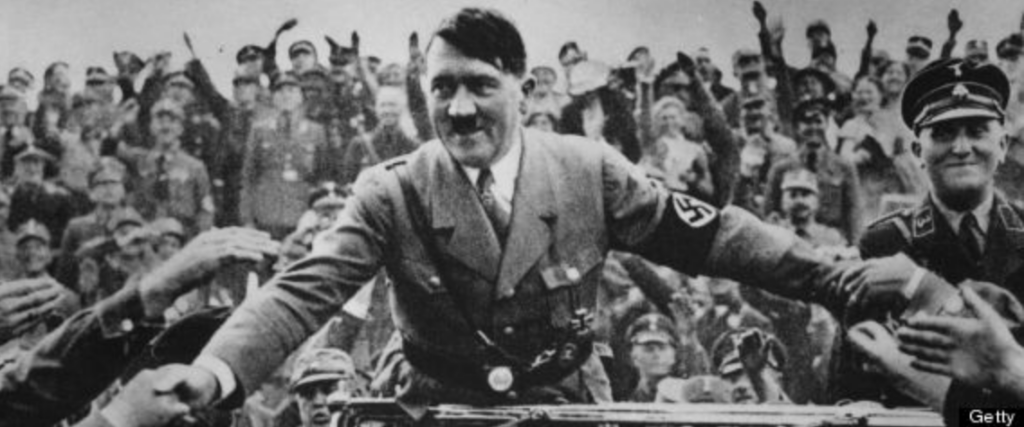Source Article Originally Posted Here
Website was wiped from the internet but article can still be seen here
“After visiting these places, you can easily understand how that within a few years Hitler will emerge from the hatred that surrounds him now as one of the most significant figures who ever lived.”
– John F. Kennedy
Adolph Hitler was raised in a middle class family, and during the early years of his life his family even went through a difficult period of starvation. After being a soldier in world war I, on January 30th 1933, he found himself head of the German government, fulfilling the dream of every poor and middle class person who ever sought to make it big.
We are all familiar with the story of Hitler that the United States would like you to believe. Hitler has been made out to be one of the most “evil” people to have ever lived, slaughtering millions of innocent jews. This same story has been echoed throughout Hollywood for decades, and by now it’s safe to say billions of dollars have been spent to convince you of this black and white, good vs evil perspective about the Nazi regime. What if it isn’t entirely accurate?
After investigating the work of others who have documented history in an unbiased fashion, as well as those who have interviewed people who worked and lived alongside Hitler, there is strong evidence to suggest that what we’ve been told is extremely inaccurate. A completely new examination of Hitler and Nazi Germany during World War II is required, and from this examination a different story is sure to emerge.
Here are 12 things you were not told about Adolph Hitler and Nazi Germany:
1. Hitler Broke Free from the International Banking Cartels
When Hitler’s period as Chancellor of Germany began, the German people had no work, no money and were starving. A wheelbarrow full of 100 billion-mark banknotes could not buy a loaf of bread at the time, and many Germans were living in shacks after countless homes and farms had been seized by Rothschild/Rockefeller-controlled banks.
In his 1967 book The Magic of Money, Hitler’s Reichsbank President, Dr. Hjalmar Horace Greeley Schacht, let out the big secret:
“The mark’s dramatic devaluation began soon after the Reichsbank was “privatized,” or delivered to private investors.”
In other words, responsible for the post-war hyperinflation was not the German government, but rather the privately owned central bank in Germany, and its monopoly it had over the creation of money. Germany’s economy was crashed and devastated by bankers… that is, until Hitler arrived.
After Hitler was elected, refusing to play ball with the Rockefeller-Rothschild rules, one of the first things he did was fix the corrupt, debt-based financial system. By completely thwarting the international banking cartels, the Nazi government issued its own currency known as Reich Marchs, which were debt free and uncontrollable by international financial interests.
Debt Free Finance = Freedom
If America nationalized their currency as Hitler did for Germany, they would effectively sever all ties with international bankers, the manipulation of their government and economy would cease, and they would live debt-free. Just as Hitler issued debt-free currency for Germany, Abraham Lincoln setup an interest free banking system in the United States when he was President, and he was murdered for it. Former US president Andrew Jackson issued interest-free currency, and two shots were fired at his head in an assassination attempt, but the shots misfired and he survived. John F. Kennedy issued interest-free currency during his presidency and we all know how he met his untimely demise.
After Germany’s public banking system was installed, world Jewry responded by declaring war on Germany, including a global boycott of German goods. Within two years, the German economy was flourishing with its new-found stable, and inflation-free currency.
2. Hitler Created a Thriving Economy with No Unemployment
After setting up a public banking system, Hitler began his reign by constructing new roads, bridges, dams, canals, port facilities, and much needed repair of public and private buildings.
Everything was done with public money that owed no interest to the International “Banksters”. As Hitler said, “For every Mark issued, we required the equivalent of a Mark’s worth of work done, or goods produced.�?
Next, the NAZI government encouraged women to be homemakers, and all the work being done to repair and improve the country’s infrastructure and transportation created jobs for men. The unemployment problem had been solved within only two years, and Germany was back on its feet.
It’s often been claimed, that Hitler’s success in reviving his nation’s economy was based largely on government spending for rearmament. This is a myth. As the renowned British historian A. J. P. Taylor noted: “Germany’s economic recovery, which was complete by 1936, did not rest on rearmament; it was caused mainly by lavish expenditure on public works, particularly on motor roads, and this public spending stimulated private spending also, as [British economist John Maynard] Keynes had said it would. …while nearly everyone else in Europe expected a great war, Hitler was the one man who neither expected nor planned for it.�?
– A. J. P. Taylor, From Sarajevo to Potsdam (Harcourt Brace Jovanovich, 1975), p. 140.
3. Hitler Emphasized Respect for Women, Children and Strong Family Values
During the economic hardship just before Hitler was elected, Germany was seeing a declining rate of birth. In 1933, hitler passed a law that enabled married couples to obtain interest free loans minimum 1000 Reich Marks (equal to 9 months salary) to set up homes and start families.
For each child birthed, the couple was allowed to keep 250 marks and did not have to repay it. This system pioneered by the Nazi government exists today in Switzerland. In the eyes of Nazis, women were viewed as the preservers of the tribe, the guardians of future generations, and the priestesses of domestic virtue.
Recognizing that families are the primary unit around which a functioning society is built, Hitler emphasized the principle of maintaining a strong bond among family members. Admired for his high regard for mother’s, families were inspired and strengthened under the leadership of Hitler.
Poor families were helped by using financial incentives, and family allowances, marriage loans and child subsidies were provided equally to each and every segment of society.
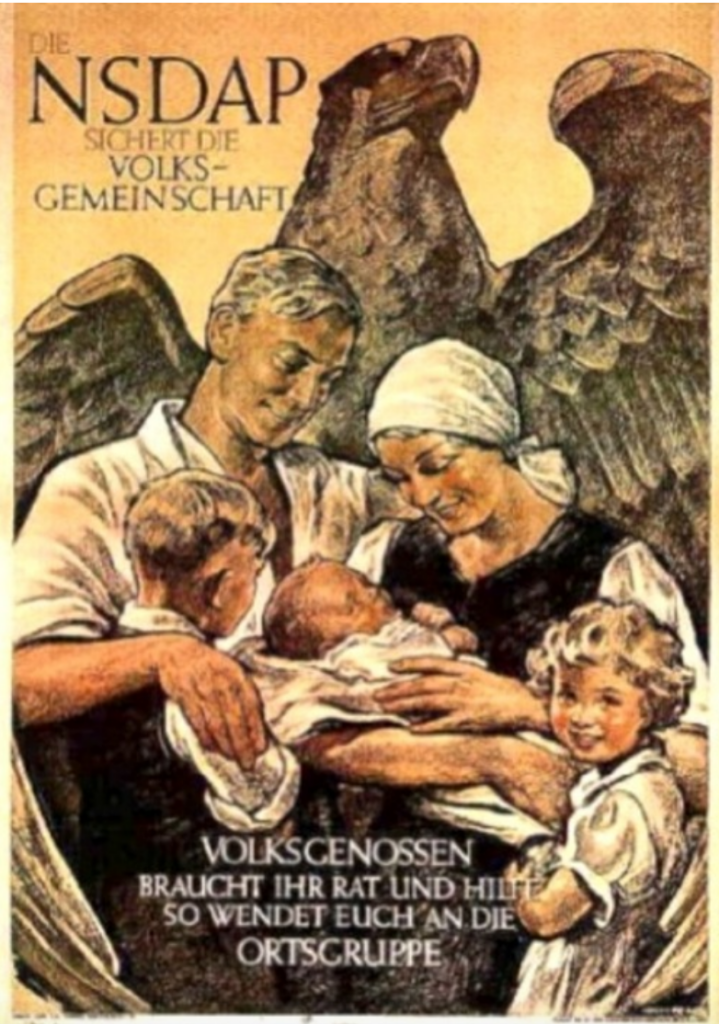
4. Nazi Preservation of Environment and Animals
Under the Nazi regime, mishandling an animal was considered a heinous crime, and if somebody was discovered mistreating an animal, they were sent to concentration camps. As someone with great admiration for animals, Hitler showed great concern for animals native to Germany, and passed laws that ensured their safety and well-being.
In 1934, Hitler passed a law called Das Reichsjagdgesetz (the Reich Hunting Law), which regulated how many animals could be killed per year, and to establish proper ‘hunting seasons’. This law has now been adopted by most western countries.
Animal conservation was included in Primary, Secondary and College levels, and in 1935, the Reichsnaturschutzgesetz (Reich Nature Protection Act) was passed. which placed several native species on a protection list including the wolf and Eurasian lynx. It is likely that this law saved some native forest-inhabiting species from going extinct.
The Nazi’s were also the first to create environmental protection laws in history. The German Imperial Conservation law of 1935 was passed, which protected “remaining portions of landscape in free nature whose preservation on account of rarity, beauty, distinctiveness or on account of scientific, ethnic, forest, or hunting significance lies in the general interest.�?
“[It is] useful to know the laws of nature – for that enables us to obey them. To act otherwise would be to rise in revolt against heaven.”
– Adolf Hitler
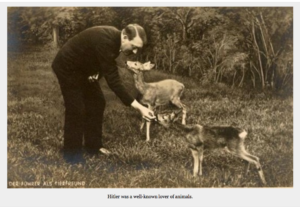
Hitler was a well-known lover of animals.
5. Hitler Banned Experimentation on Animals (Vivisection)
Nazy Germany was the first country in the world to ban vivisection, or any experimentation on live animals. With its great concern for animal conservation, and human treatment, a complete ban of vivisection was enacted in April 1933.
The Prime Minister of Prussia Hermann Goring has said:
“An absolute and permanent ban on vivisection is not only a necessary law to protect animals and to show sympathy with their pain, but it is also a law for humanity itself…. I have therefore announced the immediate prohibition of vivisection and have made the practice a punishable offense in Prussia. Until such time as punishment is pronounced the culprit shall be lodged in a concentration camp.�?
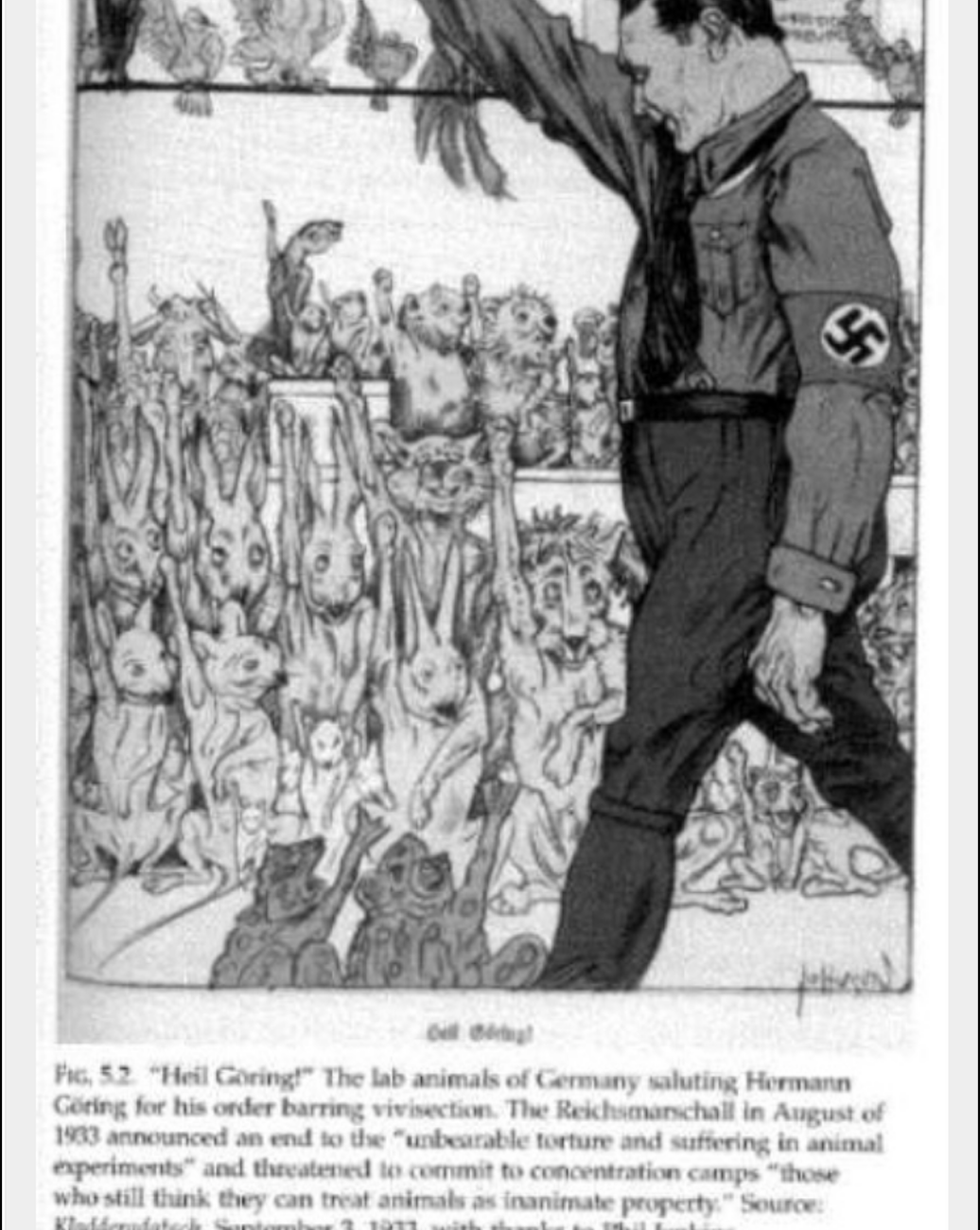
This German cartoon depicts animals that were saved from vivisection saluting Hermann Goring. The sign in the window reads “Vivisection Forbidden�?.
6. Hitler Funded Research into “Free Energy” Technologies
Hitler was well aware that in order to truly escape the stronghold of economic manipulation by the international banking cartel he would need to find a way to eliminate Germany’s dependence on oil. An inexhaustible source of energy that was not monopolized by the private money cartels was required for true sovereignty, and this is what Hitler sought.
This pursuit led Germany to develop what has been called The Nazi Bell, which is described by author Joseph P. Farrell as “a hyper-dimensional physics device being researched under the auspices of the SS departments Entwicklungstelle-IV, Forschung, Entwicklung, und Patente, and SS General Hans Kammler’s super-secret weapons black projects think-tank, the Kammlerstab.“
According to Farrell, “the mission brief of the Entwicklungstelle IV was to develop free energy and to make Germany independent of foreign oil.”

The Nazi Bell was designed, in Farrell’s estimation, for a threefold purpose:
-
Energy Independence
-
Advanced Propulsion Technology
-
A Weapon of Tremendous Power
In his book Babylon’s Banksters, Joseph P. Farrell points to evidence that after the War, the United States made every effort to reconstruct the personnel team that worked on the Nazi Bell, so that they could develop the technology for themselves and restore the balance of power between “Nazi International” and “Anglo-American” elite factions.
7. German Workers Were Well-Treated
With the goal of enhancing the standard of living for all German citizens equally, Adolph Hitler stimulated the spirit of integrity, comradeship and happiness, by funding numerous worker’s welfare programs including:
-
Highly Subsidized International vacation trips.
-
134,000 theater and concert events for 32 million people (Between 1933-1938). 2 million people went on cruises, and 11 million went on theater trips.
-
Every citizen was given a radio.
-
A 5 day work week for all citizens.
-
Free Public Health.
-
Hitler’s government banned Trade Unions, and it was mandatory that all workers had to join the German labor Front trade union. Strikes were banned, and people who refused to work were imprisoned.
-
Every large factory had to provide rest areas, cafeterias, dressing rooms, even playing fields and swimming pools for its workers.
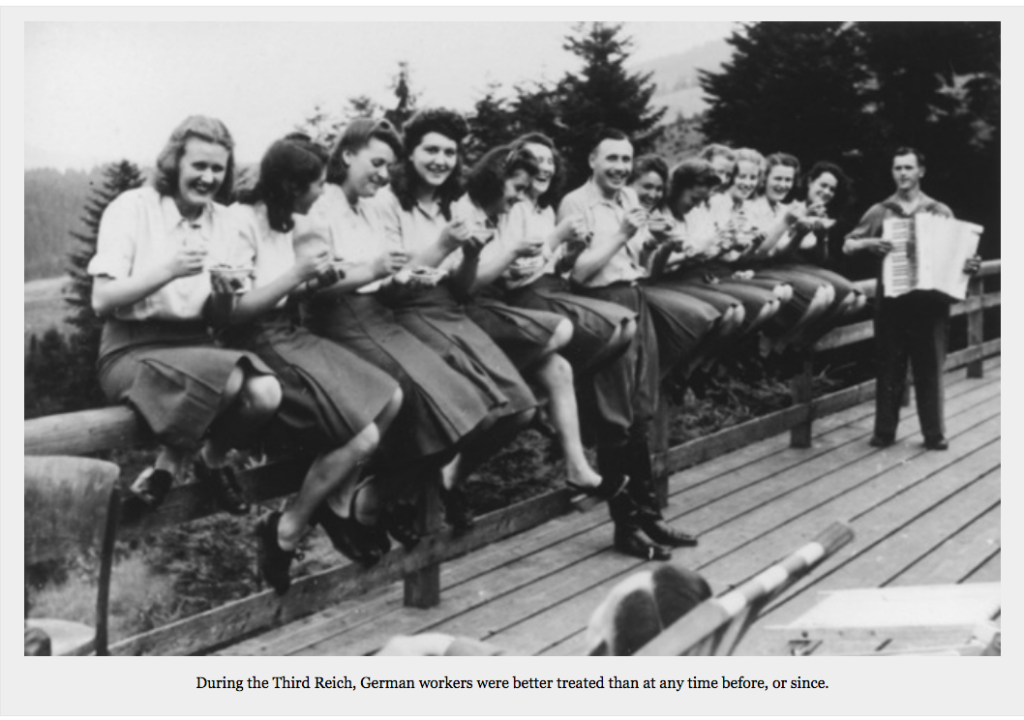
8. Organized Industrial Production & Farming
As opposed to the current American economy, where production is driven by the pursuit of maximum profit, Hitler initiated a policy of self-sufficiency, where the goal was to produce only what is required by Germans. The goal of the Nazi government was to produce for its country everything the German people needed without having to rely on imports to meet the needs of its citizens.
Along with the calculated production of material goods, new policies were introduced so that the aim of farming was to produce what German’s needed, not what was most profitable. The government subsidized the farmers for loss of profit and farmers were given guarantees that all of what was grown would be purchased.
9. Hitler Eliminated Crime and Improved Health of Germans
By giving social misfits and criminals jobs, Adolph Hitler was able to reduce the crime rate in Germany. In his 1976 book The Twelve-Year Reich, author R. Grunberger stated that there were significant drops in the rates of murder, robbery, theft, embezzlement and petty larceny during the Hitler years.
Many foreigners were impressed by the improved outlook and health of Germans, including Sir Arnold Wilson, a British M.P. who visited Germany seven times after Hitler came to power.
“Infant mortality has been greatly reduced and is considerably inferior to that in Great Britain,�? wrote Wilson. “Tuberculosis and other diseases have noticeably diminished. The criminal courts have never had so little to do and the prisons have never had so few occupants. It is a pleasure to observe the physical aptitude of the German youth. Even the poorest persons are better clothed than was formerly the case, and their cheerful faces testify to the psychological improvement that has been wrought within them.�?
10. No Citizen Will Starve or Freeze
A prime philosophy of Germany at the time was that all citizens should share the same standard of living. With this in mind, Nazi Germany boasted one of the largest public welfare programs in history with the slogan “None shall starve nor freeze”. Every year, high-ranking Nazi’s and citizens would take to the streets to collect charity for the unfortunate, which generated a feeling of comradeship toward those in need.

They even went to the extent of publishing names of those who didn’t give charity in the paper as a punishment or reminder of their neglect. According to Mark Weber of the Institute for Historical Review,
“On one occasion, a civil servant was prosecuted for failure to donate, and his argument that it was voluntary was dismissed on the grounds it was an extreme view of liberty, to neglect all duties not actually prescribed by law, and therefore an abuse of liberty.”
11. The Nazi Anti-Tobacco Mission
Nazi doctors were the first to write a major scientific paper linking smoking to lung cancer. Following this report, smoking was banned in restaurants and public transportation systems. Advertising of smoking and cigarettes was severely regulated by the Nazis, and tobacco tax was raised to deter people from smoking. In what was one of the most expensive and effective anti-tobacco movements in history, numerous German health organizations began educating the public that risks of miscarriage were heightened when pregnant women engaged in smoking.
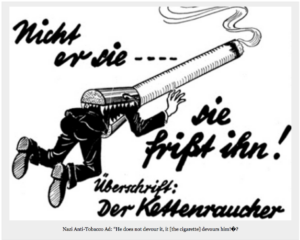
Nazi Anti-Tobacco Ad: “He does not devour it, it [the cigarette] devours him!�?
In the year 1940, while annual cigarette consumption per capita in America was over 3,000, in Germany it was only 749.
-
Hitler prohibited the sale of cigarettes to women.
-
Hitler prohibited smoking for people under the age of 18.
-
Hitler prohibited smoking for people in uniforms.
-
Hitler prohibited smoking in public areas.
-
Hitler was the first to place “warning” photos of cancerous lungs on cigarette boxes.
_
12. Nazi’s Created a Culture that Cherished Music
Recognizing the importance weaving music into the fabric of a country rich in culture, Hitler founded the State Music Institute in 1933 after he came into power. Its purpose was to promote the timeless work of composers such as Beethoven, Mozart, Brahms, Wagner, among others. The Nazis ensured that every German citizen had a radio.
Youngsters were encouraged by the Nazi government to pursue music as a career in order to preserve the rich ancient German cultural heritage. Jazz, Swing, and sexually provocative music were all banned in Germany during the Hitler era.
Resources Used:

